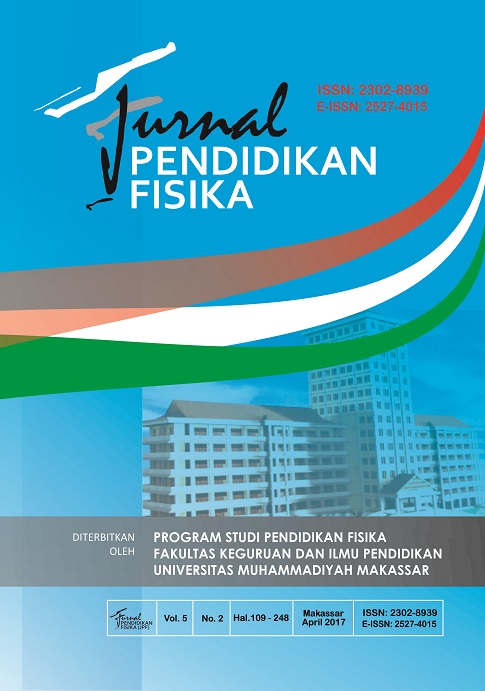Analisis Hubungan Kemampuan Numerik dengan Hasil Belajar Fisika Peserta Didik Kelas XII IPA SMA Muhammadiyah di Makassar
DOI:
https://doi.org/10.26618/jpf.v5i2.609Abstract
Penelitian ini merupakan penelitian ex-post facto yang bersifat analisis korelasional yang bertujuan untuk mengetahui tingkat kemampuan numerik dan hasil belajar fisika yang dicapai peserta didik kelas XII IPA SMA Muhammadiyah di Makassar serta hubungan antara kedua variabel tersebut. Populasi dalam penelitian ini adalah semua peserta didik kelas XII IPA SMA Muhammadiyah di kota Makassar, sampel penelitian diambil secara acak dengan teknik random sampling sebanyak 78 responden. Teknik analisis data yang digunakan adalah analisis statistik deskiptif dan analisis statistik inferensial yang meliputi uji normalitas, uji linearitas dan uji korelasi product moment. Dari hasil penelitian dapat disimpulkan bahwa tingkat kemampuan numerik peserta didik berada dalam kategori sedang, tingkat hasil belajar fisika peserta didik berada dalam kategori rendah, dan terdapat hubungan positif yang signifikan antara kemampuan numerik dengan hasil belajar peserta didik kelas XII IPA SMA Muhammadiyah di Makassar.
Kata kunci: kemampuan numerik, hasil belajar fisika
This research is an ex-post facto with correlational analysis which aimed to find out the level and correlations between numerical ability and physics achievement of students of classes XII IPA SMA Muhammadiyah at Makassar. Population this research are all of students of classes XII IPA SMA Muhammadiyah at Makassar, the sampling technique was random sampling obtained 78 respondens. The data was analysed by descriptive statistical analysis and inferential statistical analysis include normality test, linearity test and correlation of product moment test. Based on this research, it can be concluded that the level of numerical ability of students was in medium category, the level of physics achivement of student was in low category and there was positive and significant correlation between numerical ability and physics achievment of students of classes XII IPA SMA Muhammadiyah at Makassar.
Key words: numerical ability, physics achivement
References
C. Tzanakis, On The Relationship Between Mathematics and Physics in Undergraduate Teaching-Online Journal, 2002. Website: http://www.math.uoc.gr/~ictm2/Proceedings/pap319.pdf, diakses tanggal 1 Januari 2016.
Satria Afriza, Ahmad Hamid dan Marwan AR, Pengaruh Kemampuan Numerik terhadap Hasil Belajar Fisika Siswa Kelas XI SMA Negeri 5 Banda Aceh. Jurnal Ilmiah Mahasiswa (JIM) Pendidikan Fisika. Volume 1(4). 2016. Unsyiah.
Depdiknas, Standar Kompetensi Mata Pelajaran Fisika Sekolah Menengah Atas dan Madrasah Aliyah, 2003. Website: http://sasterpadu.tripod.com/sas_store/Fisika.pdf, diakses tanggal tanggal 8 Agustus 2015.
Mundilarto, Kapita Selekta Pendidikan Fisika, 2002. Website: http://staff.uny.ac.id/sites/default/files/130681033/Bab%20I%20&%20II.pdf, diakses tanggal tanggal 12 Maret 2015.
Dwi Sambada, “Peranan kreativitas siswa terhadap kemampuan memecahkan masalah fisika dalam pembelajaran konstekstual”. Jurnal Pendidikan Fisika dan Aplikasinya (JPFA). Vol 2 (2). 2012.
Mundilarto, Kemampuan Mahasiswa Menggunakan Pendekatan Analisis Kuantitatif dalam Memecahkan Soal Fisika, 2001. Website: http://eprints.uny.ac.id/5028/1/KEMAMPUAN_MAHASISWA_MENGGUNAKAN.pdf, diakses tanggal tanggal 8 Agustus 2015.
G. Polya, How to Solve It (A New Aspect Of Mathematical Method), New Jersey: Princeton University Press, 1973.
Funda Ornek dkk, “What Makes Physics Difficult”. International Journal of Environtment & Science Education. Vol 1 (3), 2008.
Tri Indra Prasetya, Meningkatkan Keterampilan Menyusun Instrumen Hasil Belajar Berbasis Modul Interaktif bagi Guru-Guru IPA SMPN Kota Magelang. Journal of Educational Research and Evaluation 1 (2). 2012. Universitas Negeri Semarang.
Masnur Muslich, Authentic Assessment: Penilaian Berbasis Kelas dan Kompetensi. Bandung: Refika Aditama. 2011.
Retno Utari, 2011. Taksonomi Bloom: Apa dan Bagaimana Menggunakannya?. Website:http://www.bppk.depkeu.go.id/webpkn/attachments/article/766/1-Taksonomi%20Bloom%20-%20Retno-ok-mima+abstract.pdf, diakses tanggal 26 Juni 2016.
D.C Wibowo, N. Dantes, dan Sariyasa, Pengaruh Implementasi Pendekatan Matematika Realistik terhadap Prestasi Belajar Matematika dengan Kovariabel Kemampuan Numerik dan Inteligensi pada Siswa Kelas V. Jurnal Program Pascasarjana Universitas Pendidikan Ganesha. Volume 3. 2013.
Farah Indrawati, Pengaruh Kemampuan Numerik dan Cara Belajar terhadap Prestasi Belajar Matematika. Jurnal Formatif. Volume 3(3). 2012, pp.215-223, ISSN: 2088-351X.
Ida Ayu Komang Astuti, A.A.I.N. Marhaeni, Sariyasa, Pengaruh Pendekatan Matematika Realistik terhadap Prestasi Belajar Matematika Ditinjau dari Kemampuan Numerik. Jurnal Pendidikan Dasar. Volume 3. 2013. Program Pascasarjana Universitas Pendidikan Ganesha.
Al Jupri dan Rohma Mauhibah, Lulus Ujian dengan TPA Matematika. Jakarta: Gagas Media. 2012.
Sarwadi, Khairul Ummah K. Yuliana dan Agustina Pandhuniawati Heryani BIG DRILLING Soal+Pembahasan PSIKOTES. Yogyakarta: Pustaka Baru Press. 2015.
Downloads
Published
Issue
Section
License
Copyright:
Authors who publish with this journal agree to the following terms:
1. Authors retain copyright and grant the journal right of first publication with the work simultaneously licensed under a Creative Commons Attribution-ShareAlike 4.0 International License that allows others to share the work with an acknowledgement of the work's authorship and initial publication in this journal.
2. Authors are able to enter into separate, additional contractual arrangements for the non-exclusive distribution of the journal's published version of the work (e.g., post it to an institutional repository or publish it in a book), with an acknowledgement of its initial publication in this journal.
3. Authors are permitted and encouraged to post their work online (e.g., in institutional repositories or on their website) prior to and during the submission process, as it can lead to productive exchanges, as well as earlier and greater citation of published work.
Licence:
Authors are free to:
1. Share: Copy and redistribute the material in any medium or format
2. Adapt: Remix, transform, and build upon the material for any purpose, even commercially.
The licensor cannot revoke these freedoms as long as the authors follow the license terms, which include the following:
1. Attribution: You must give appropriate credit, provide a link to the license, and indicate if changes were made. You may do so in any reasonable manner, but not in any way that suggests the licensor endorses you or your use.
2. ShareAlike: If you remix, transform, or build upon the material, you must distribute your contributions under the same license as the original.
3. No additional restrictions: You may not apply legal terms or technological measures that legally restrict others from doing anything the license permits.
Jurnal Pendidikan Fisika is licensed under a Creative Commons Attribution-ShareAlike 4.0 International License.

